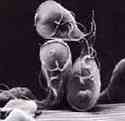
Chemical Water Treatment
Purpose
 Chemical treatment of drinking water is meant to poison all the little critters doing the backstroke in your drink but not poison you. A tiny amount of chemicals will kill little pests, but too much will kill dudes or at least make you really sick. Carefully follow directions with purification products and things go just fine. There are some folks that are allergic to iodine or may be super sensitive to chemicals so it would be good to always be cautious and try out products at home before using them in the wild.
Chemical treatment of drinking water is meant to poison all the little critters doing the backstroke in your drink but not poison you. A tiny amount of chemicals will kill little pests, but too much will kill dudes or at least make you really sick. Carefully follow directions with purification products and things go just fine. There are some folks that are allergic to iodine or may be super sensitive to chemicals so it would be good to always be cautious and try out products at home before using them in the wild.
 Chemical purifiers are very dependent on product freshness, water clarity and temperature, dosage strength, and water exposure time.
Chemical purifiers are very dependent on product freshness, water clarity and temperature, dosage strength, and water exposure time.
Follow these general guidelines to successfully purify your drinking water with chemicals:
- Make sure the product you are using has not passed the expiration date on the package
- Be sure it has not lost its strength because it was left open too long
- Pre-filter the water to at least remove visible impurities
- Use full doses as the product instructs
- Wait at least the recommended contact time for the product to work
- Extend the contact time for colder water
- Use neutralizing chemicals to help with the taste, if they are available
- Add flavor, like lemonade, or just vitamin C, AFTER the required contact time has passed
- Don't use iodine for more than a couple weeks
Chemically treating water kills off the bad stuff, but leaves it floating around in there. If you don't mind drinking water full of crud and smelling or tasting like chemicals, then chemical treatment is a good, low-weight, compact system to use. I prefer to use it as an insurance policy rider with my filter. I will treat with chemicals and then filter. That kills they little things my filter can't get and then removes at least the visible crud. The carbon element in my filter also helps with the chemical left-over taste and smell.
Common Chemicals
Chlorine Dioxide releases nascent oxygen, a highly active form of oxygen, which is a strong oxidant and a powerful germicidal agent. Chlorine dioxide is used by municipal water treatment plants to kill a variety of waterborne pathogens. Unlike chlorine (familiar as household bleach) or other halogen chemicals (such as iodine), chlorine dioxide does not create potentially harmful by-products.
Chlorine has been used for hundreds of years as a water disinfectant. The common complaint is about its taste and it may not completely take care of Giardia, which is a common backpacking concern, or cryptosporidia because they are such hard-shelled cysts.
Iodine is another historic treatment, but has been generally replaced by chlorine dioxide products. It shouldn't be used for weeks on end. It may not be completely effective against cryptosporidia.
When you do use chemicals, don't plan to use them for an extended time and plan your day to have the 30 minutes to 4 hours required for the critters to die off before consuming the treated water.

